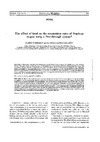Identificador persistente para citar o vincular este elemento:
https://accedacris.ulpgc.es/jspui/handle/10553/1202
| Campo DC | Valor | idioma |
|---|---|---|
| dc.contributor.author | Schmoker, Claire | en_US |
| dc.contributor.author | Hernandez-Leon, S | en_US |
| dc.contributor.other | Facultad de Ciencias del Mar | - |
| dc.date.accessioned | 2009-10-08T02:31:00Z | - |
| dc.date.accessioned | 2018-03-01T13:49:03Z | - |
| dc.date.available | 2018-03-01T13:49:03Z | - |
| dc.date.issued | 2003 | en_US |
| dc.identifier.isbn | 2148358 | - |
| dc.identifier.issn | 0214-8358 | en_US |
| dc.identifier.other | 863 | - |
| dc.identifier.other | WoS | - |
| dc.identifier.uri | https://accedacris.ulpgc.es/handle/10553/1202 | - |
| dc.description.abstract | Respiration rates and gut fluorescence of the cladoceran Daphnia magna were studied using a flow-through system. This open system has the advantage of introducing food or producing a starvation effect during the course of the experiment. Severe variations in respiratory rates were observed in relation to the presence or absence of food, indicating short-term variability. Organisms kept starved or at low food for a long period (15-20 h) responded to a sudden increase in food by increasing their respiration rates three- to four-fold in parallel with their gut content. A significant relationship between gut fluorescence and respiration rates was observed, suggesting that feeding and the related swimming activity were responsible for the observed metabolic variability. | en_US |
| dc.language | eng | en_US |
| dc.relation.ispartof | Scientia Marina | en_US |
| dc.source | Scientia Marina [ISSN 0214-8358], v. 67 (3), p. 361-365, (Septiembre 2003) | en_US |
| dc.subject | 251001 Oceanografía biológica | en_US |
| dc.subject.other | Diel Vertical Migration | en_US |
| dc.subject.other | Copepod Acartia-Tonsa | en_US |
| dc.subject.other | Dynamic Action Sda | en_US |
| dc.subject.other | Egg-Production | en_US |
| dc.subject.other | Metabolic-Rate | en_US |
| dc.subject.other | Mesozooplankton | en_US |
| dc.subject.other | Assimilation | en_US |
| dc.subject.other | Chlorophyll | en_US |
| dc.subject.other | Temperature | en_US |
| dc.subject.other | Zooplankton | en_US |
| dc.subject.other | Metabolism | en_US |
| dc.subject.other | Feeding | en_US |
| dc.title | The effect of food on the respiration rates of Daphnia magna using a flow-through system | en_US |
| dc.title.alternative | El efecto del alimento sobre las tasas de respiración de Daphnia Magna mediante el uso de un sistema abierto | en_US |
| dc.type | info:eu-repo/semantics/article | en_US |
| dc.type | Article | en_US |
| dc.identifier.doi | 10.3989/scimar.2003.67n3361 | en_US |
| dc.identifier.scopus | 0242710888 | - |
| dc.identifier.isi | 000185680400012 | - |
| dc.contributor.authorscopusid | 12645338600 | - |
| dc.contributor.authorscopusid | 6701465678 | - |
| dc.contributor.contentdm | Facultad de Ciencias del Mar | - |
| dc.identifier.absysnet | 294547 | - |
| dc.identifier.crisid | - | - |
| dc.description.lastpage | 365 | en_US |
| dc.identifier.issue | 3 | - |
| dc.description.firstpage | 361 | en_US |
| dc.relation.volume | 67 | en_US |
| dc.investigacion | Ciencias | en_US |
| dc.rights.accessrights | info:eu-repo/semantics/openAccess | - |
| dc.type2 | Artículo | en_US |
| dc.contributor.daisngid | 3581027 | - |
| dc.contributor.daisngid | 489706 | - |
| dc.description.numberofpages | 5 | en_US |
| dc.utils.revision | Sí | en_US |
| dc.contributor.wosstandard | Facultad de Ciencias del Mar | - |
| dc.contributor.wosstandard | WOS:Schmoker, C | - |
| dc.contributor.wosstandard | WOS:Hernandez-Leon, S | - |
| dc.date.coverdate | Enero 2003 | en_US |
| dc.identifier.supplement | - | - |
| dc.identifier.ulpgc | Sí | es |
| dc.description.jcr | 0,635 | |
| dc.description.jcrq | Q4 | |
| dc.description.scie | SCIE | |
| item.fulltext | Con texto completo | - |
| item.grantfulltext | open | - |
| crisitem.author.dept | GIR IOCAG: Oceanografía Biológica y Cambio Global | - |
| crisitem.author.dept | IU de Oceanografía y Cambio Global | - |
| crisitem.author.dept | Departamento de Biología | - |
| crisitem.author.orcid | 0000-0002-3085-4969 | - |
| crisitem.author.parentorg | IU de Oceanografía y Cambio Global | - |
| crisitem.author.fullName | Hernández León, Santiago Manuel | - |
| Colección: | Artículos | |
Citas SCOPUSTM
15
actualizado el 08-jun-2025
Citas de WEB OF SCIENCETM
Citations
13
actualizado el 25-feb-2024
Visitas
89
actualizado el 10-ene-2026
Descargas
132
actualizado el 10-ene-2026
Google ScholarTM
Verifica
Altmetric
Comparte
Exporta metadatos
Los elementos en ULPGC accedaCRIS están protegidos por derechos de autor con todos los derechos reservados, a menos que se indique lo contrario.
